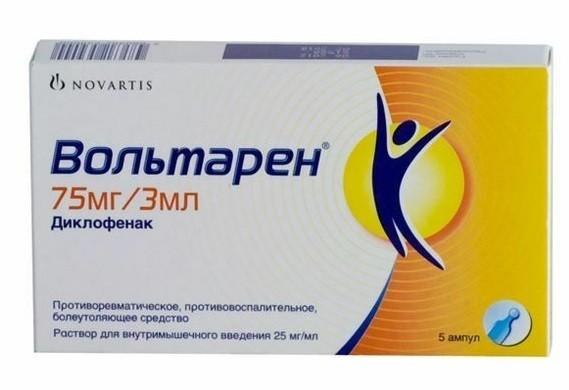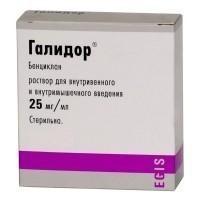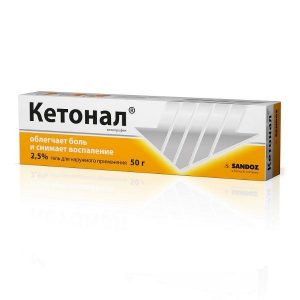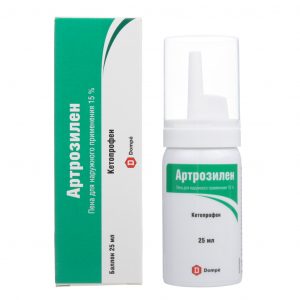Description
Release form
Intramuscular solution.
packaging
in 1 ampoule of 3 ml of solution. In a package of 5 ampoules.
Pharmacological action of
NSAIDs. Voltaren contains diclofenac sodium, a non-steroidal substance that has a pronounced anti-inflammatory, analgesic and antipyretic effect.
Inhibition of prostaglandin biosynthesis is considered the main mechanism of action of diclofenac, established under experimental conditions. Prostaglandins play an important role in the genesis of inflammation, pain, and fever.
In vitro diclofenac sodium in concentrations equivalent to those achieved in treating patients does not inhibit the biosynthesis of cartilaginous proteoglycans.
In rheumatic diseases, the anti-inflammatory and analgesic properties of Voltaren provide a clinical effect, characterized by a significant decrease in the severity of such manifestations of diseases as pain at rest and during movement, morning stiffness and swelling of the joints, as well as an improvement in the functional state.
In post-traumatic and postoperative inflammatory conditions, Voltaren quickly relieves pain (occurring both at rest and during movement), reduces inflammatory edema and edema of the postoperative wound.
Contraindications
gastric or intestinal ulcer
history of bronchial asthma attacks, urticaria, acute rhinitis associated with the use of acetylsalicylic acid or other NSAIDs, as well as any drugs that suppress the production of prostaglandins
rk only age up to 14 years
hypersensitivity to diclofenac and any other ingredients of the drug.
Use during pregnancy and lactation
Use of Voltaren during pregnancy is possible only in cases where the expected benefit to the mother outweighs the potential risk to the fetus.
The drug is prescribed in the minimum effective dose. As with other prostaglandin synthetase inhibitors, these recommendations are especially important in the third trimester of pregnancy (suppression of uterine contractility and premature closure of the ductus arteriosus in the fetus is possible).
The use of Voltaren in the form of a solution for i / m administration during pregnancy is not recommended.
If it is necessary to administer Voltaren in the form of a solution for intramuscular administration during lactation, the question of stopping breastfeeding should be decided.
Special instructions
During the use of Voltaren, careful medical monitoring of those patients who have complaints indicating gastrointestinal diseases who have a history of ulcerative lesions of the stomach or intestines with ulcerative colitis or Crohn’s disease, as well as those with impaired liver function, is necessary.
Against the background of the use of Voltaren, gastrointestinal bleeding can occur at any time (for the first time or repeatedly) or ulceration / perforation of the gastrointestinal tract may occur, with or without the symptoms of the precursors. More serious consequences of these complications may occur in elderly patients. In those rare cases when patients receiving Voltaren develop these complications, the drug should be discontinued.
At the first use of Voltaren, as well as other NSAIDs, in rare cases allergic reactions can develop, including anaphylactic and anaphylactoid reactions.
Voltaren, due to its pharmacodynamic properties, can mask the manifestations of infectious diseases.
Voltaren, like other NSAIDs, can temporarily inhibit platelet aggregation. Therefore, in patients with hemostatic disorders, careful monitoring of relevant laboratory parameters is necessary.
With prolonged use of Voltaren, like other NSAIDs, a systematic monitoring of the peripheral blood picture is indicated.
Influence on the ability to drive vehicles and operate machinery:
Patients who experience dizziness or other disorders of the central nervous system, including visual impairment, should not drive a car or operate machinery while using the drug while using Voltaren.
Composition of
1 ml of solution contains:
Active ingredient: diclofenac (in the form of sodium salt) – 25 mg (1 ampoule – 75 mg)
Excipients: mannitol, sodium disulfite, benzyl alcohol, propylene glycol, d / u water, sodium hydroxide.
Dosage and Administration
Intramuscularly.
Voltaren is administered by deep injection into the gluteal muscle. Do not use Voltaren injections for more than 2 consecutive days. If necessary, treatment can be continued with Voltaren in the form of tablets or rectal suppositories.
When carrying out an intramuscular injection in order to avoid damage to a nerve or other tissues, it is recommended to inject the drug deeply in / m into the upper outer quadrant of the gluteal region.
The dose is usually 75 mg (contents of 1 ampoule) 1 time / day.
In severe cases (for example, with colic) as an exception, 2 injections of 75 mg can be given with an interval of several hours (the second injection should be carried out in the opposite gluteal region). Alternatively, one injection of the drug per day (75 mg) can be combined with other dosage forms of Voltaren (tablets, rectal suppositories), while the total daily dose should not exceed 150 mg.
Side effects of the
Digestive system:
Sometimes – epigastric pain, nausea, vomiting, diarrhea, abdominal cramps, dyspepsia, flatulence, anorexia, increased activity of aminotransferases in the blood serum.
Rarely, gastrointestinal bleeding (vomiting of blood, melena, diarrhea mixed with blood), stomach and intestinal ulcers, accompanied or not accompanied by bleeding or perforation, hepatitis, accompanied or not accompanied by jaundice.
In some cases – aphthous stomatitis, glossitis, damage to the esophagus, occurrence of diaphragm-like strictures in the intestine, disorders of the distal colon, such as nonspecific hemorrhagic colitis, exacerbation of ulcerative colitis or Crohn’s disease, constipation, pancreatitis, fulminant hepatitis.
From the side of the central nervous system and peripheral nervous system:
Sometimes – headache, Dizziness
Rarely – drowsiness.
In some cases, sensory disturbances, including paresthesia, memory disorders, disorientation, insomnia, irritability, cramps, depression, anxiety, nightmares, tremors, psychotic reactions, aseptic meningitis.
On the part of the sensory organs:
In some cases – visual impairment (blurred vision, diplopia), hearing impairment, tinnitus, taste disturbance.
From the cardiovascular system:
In some cases – a feeling of palpitations, chest pain, increased blood pressure, worsening congestive heart failure.
Dermatological reactions:
Sometimes – skin rashes.
Rarely – urticaria.
In some cases, bullous rashes, eczema, erythema multiforme, Stevens-Johnson syndrome, Lyell syndrome (acute toxic epidermal necrolysis), erythroderma (exfoliative dermatitis), hair loss, photosensitivity reactions, purpura (including allergic).
From the urinary system:
Rarely, edema.
In some cases, acute renal failure, hematuria, proteinuria, interstitial nephritis, nephrotic syndrome, papillary necrosis.
From the hemopoietic system:
In some cases – thrombocytopenia, leukopenia, hemolytic anemia, aplastic anemia, agranulocytosis.
Hypersensitivity reactions:
Rarely – bronchospasm, systemic anaphylactic / anaphylactoid reactions, including hypotension.
In some cases – vasculitis, pneumonitis.
Local reactions:
Sealing, pain.
In some cases – abscesses, necrosis.
The listed side effects were observed including when using doses of the drug and the duration of treatment that differ from the recommended ones.
Drug Interactions
Voltaren may increase the concentration of lithium and digoxin in plasma while used with these drugs.
Voltaren, like other NSAIDs, may decrease the effect of diuretics. The simultaneous use of Voltaren with potassium-sparing diuretics can lead to an increase in the level of potassium in the blood (in the case of such a combination of drugs, this indicator should often be monitored).
Concomitant use of Voltaren with other NSAIDs may increase the risk of side effects.
Although clinical studies have not established the effect of Voltaren on the action of anticoagulants, there are some reports of an increased risk of bleeding in cases of their joint use. Careful monitoring of patients receiving these drugs at the same time is recommended.
Voltaren can be prescribed in conjunction with oral hypoglycemic drugs and the effectiveness of the latter does not change. However, there are separate reports of the development in such cases of both hypoglycemia and hyperglycemia, which necessitated a change in the dose of hypoglycemic drugs during the use of Voltaren.
Caution should be exercised when using NSAIDs less than 24 hours before the start of use or after the end of methotrexate therapy, as its blood level (and therefore toxicity) may increase.
The effect of NSAIDs on the activity of prostaglandins in the kidneys may enhance cyclosporine nephrotoxicity.
There are few reports of seizures in patients taking both NSAIDs and quinolone antibacterial drugs.
Do not mix Voltaren solution in ampoules with solutions of other drugs for injection.
Overdose
There is no typical clinical picture inherent in overdose with Voltaren.
Symptoms: decreased blood pressure, kidney failure, convulsions, gastrointestinal disorders and respiratory depression.
Treatment: supportive and symptomatic. Forced diuresis, hemodialysis, or hemoperfusion are unlikely to be useful for NSAIDs. the active substances of these drugs are highly bound to plasma proteins and undergo intense metabolism.
Storage conditions
Store in a dark place at a temperature not exceeding 30 ° C.
Shelf life
2 years.
Deystvuyushtee substance
Diclofenac
Terms and conditions
prescription
Dosage form
injection for injection
Possible product names s 25 0,0 25 MP0 MPLp 25 ML
Voltaren 25 mg / ml 3 ml No. 5 amp
Voltaren 25 mg / ml solution for v / m administration. 3ml Amp. X5 B M (R)
VOLTAREN 25MG / ML. 3ML. No. 5 RR D / V / M AMP.
Voltaren 75mg 3ml No. 5 amp
Novartis Farm Stein AG, Switzerland




